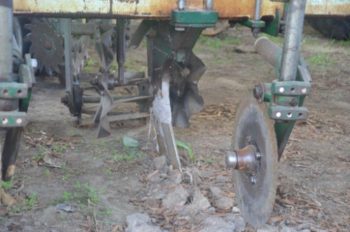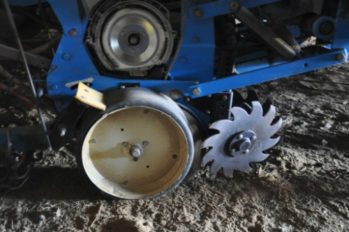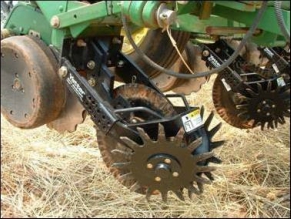How Do I Get Good Seed/Soil Contact in Cover Crop Residue?
Planting into cover crop residue can be intimidating, but there is no reason not to have a successful stand. There may be as many methods to achieving a good stand in residue as there are farmers, but there are some consistent principles to help ensure you get good seed to soil contact and a consistent stand.

Heatwole cutting coulter and shank.
Use these tips to help ensure a consistent stand:
- Use sharp coulters. For any conservation tillage planting operation, ensure a good, sharp cutting coulter is ahead of the furrow opener. Don’t skimp here. Make sure your cutting coulters stay sharp.
- Consider row cleaners for planters. There are many versions available that also include coulters to cut any remaining residue ahead of seed placement. Your goal should be to have the wheels of the row cleaners barely touching the surface to minimize soil disturbance while they sweep the residue aside just enough to allow the double disc openers clear access to the soil [Black trash cleaner and planter 2017.jpg]. This will prevent hairpinning, which reduces seed to soil contact.
- Consider different double disc openers. Some newer planters use double disc openers with a leading edge that allows for better slicing through residue. This option can help with successful planting into heavy residue.
- Use correct down pressure. Make sure you are using the correct down pressure. Planter down pressure systems may consist of springs, pneumatic, or hydraulic components that reduce planter bounce and provide consistent seeding depth. Seed firmers are another inexpensive option to ensure good seed to soil contact.
- Match closing wheels to your soil. Use the right closing wheels for your soil. Farmers who have some clayey soil near the surface prefer spiked closing wheels to prevent soil crusting. Others, with sandier textures, prefer rubber closing wheels to firm the soil and prevent soil moisture loss. Talk to farmers in your area with similar soil types to see what works best for them or contact your local Extension or NRCS office.
|
Example of row cleaner. |
Example of row cleaner. |
Contributors:
Dr. Kip Balkcom, USDA ARS National Soil Dynamic Laboratory: Julia Gaskin, Extension Specialist, University of Georgia: Nathan Lowder, NRCS Soil Health Specialist; Dr. Dara Park, Assoc. Professor, Clemson University


